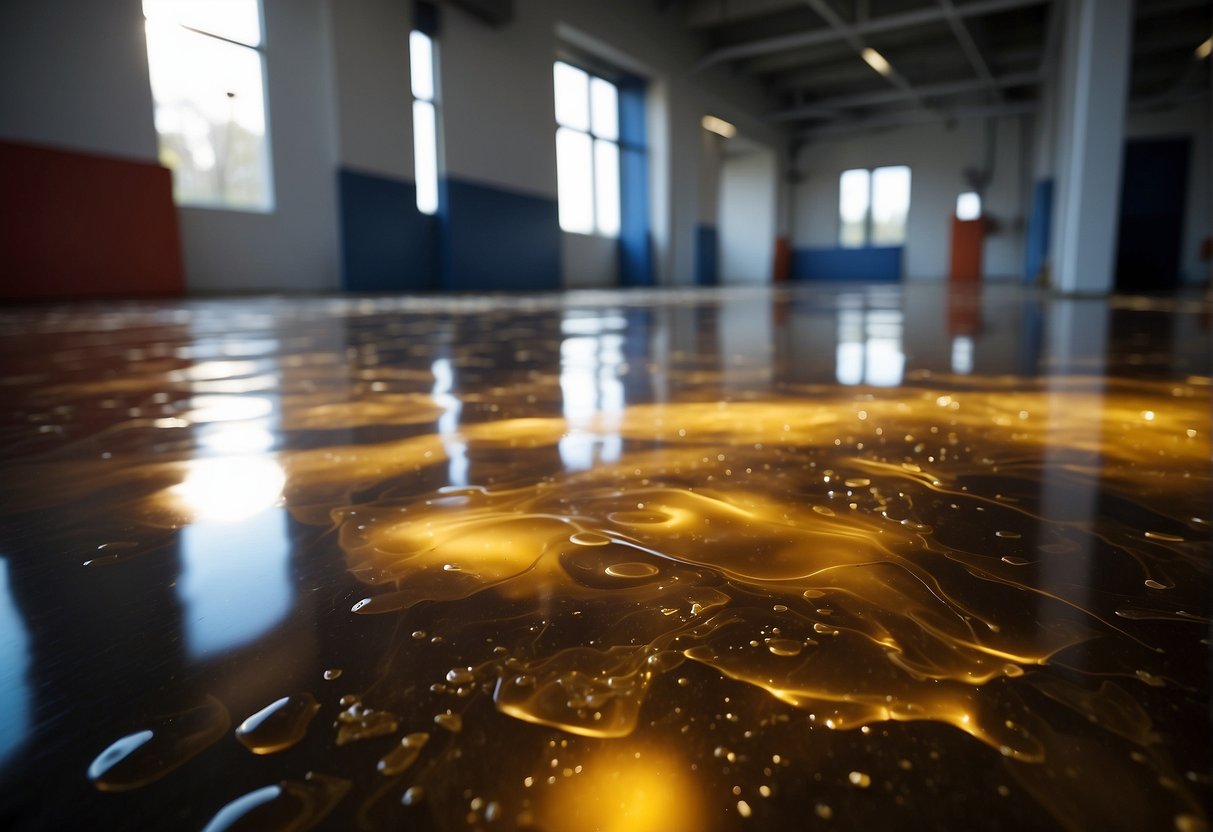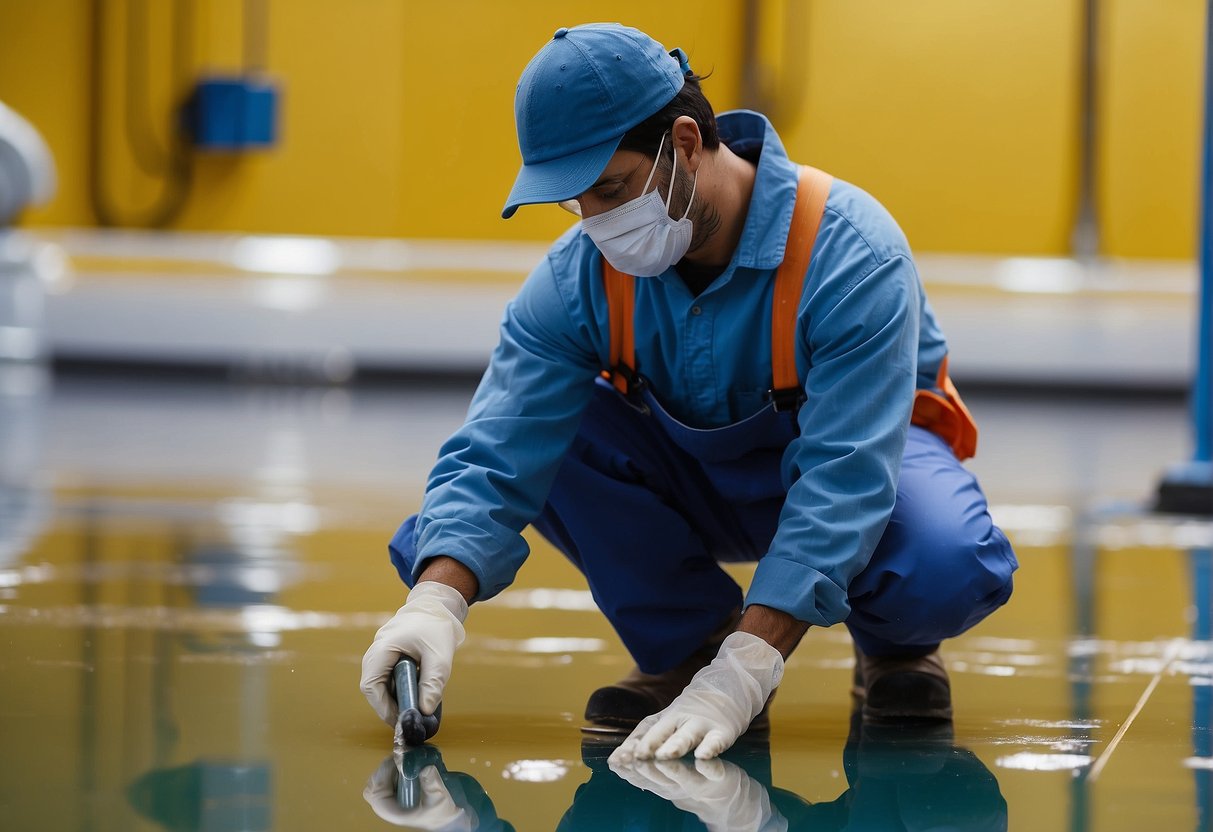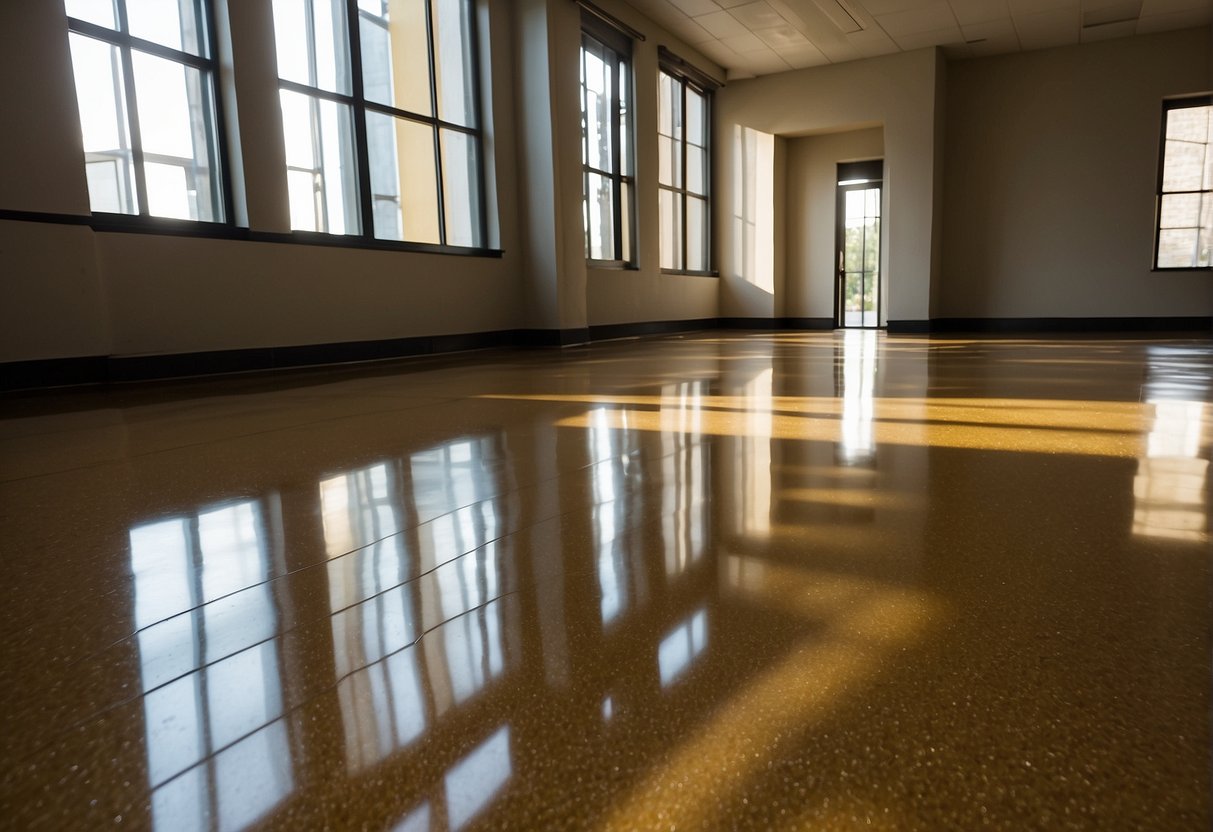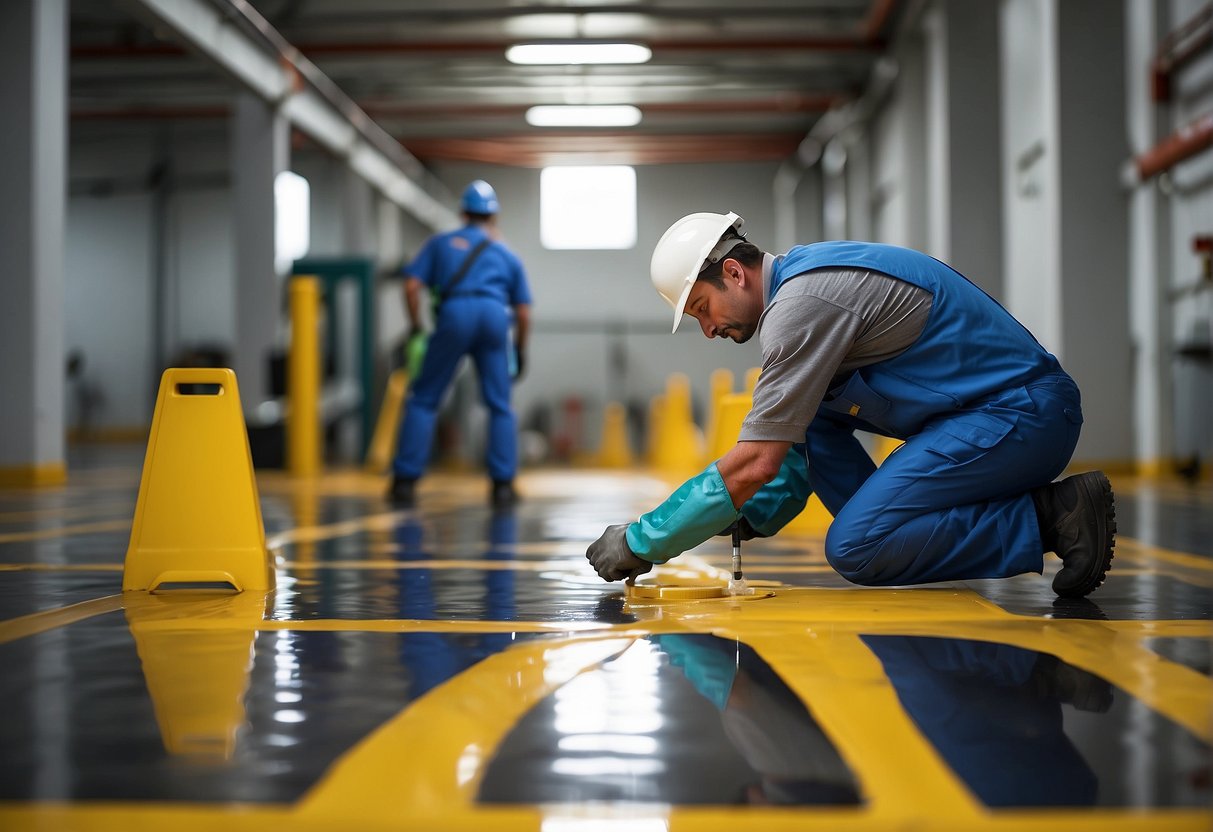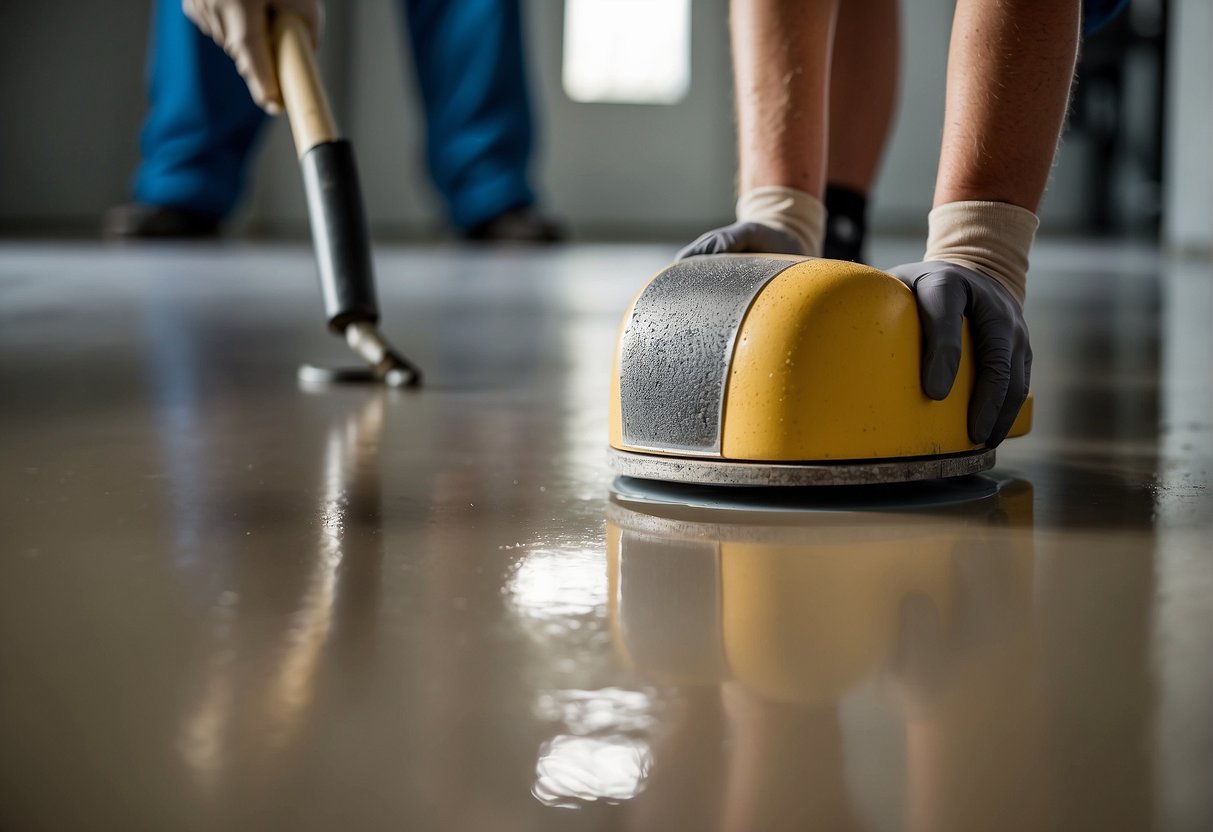Polyurethane over epoxy floor is a popular choice for garage and industrial flooring. It is a cost-effective and durable solution that offers both protective and aesthetic qualities. Applying polyurethane over epoxy requires proper preparation, including ensuring the epoxy is fully cured and sanded for a glossy finish.
Understanding the properties of epoxy and polyurethane is crucial for a successful application. Epoxy is a two-part adhesive that creates a hard, durable surface that is resistant to chemicals and abrasions. Polyurethane is a protective coating that adds an extra layer of protection against wear, UV rays, and chemicals. It is available in water-based and oil-based formulas, with water-based formulas being more clear and oil-based formulas leaving an amber hue.
Key Takeaways
- Proper preparation is crucial when applying polyurethane over epoxy, including ensuring the epoxy is fully cured and sanded for a glossy finish.
- Epoxy creates a hard, durable surface that is resistant to chemicals and abrasions, while polyurethane adds an extra layer of protection against wear, UV rays, and chemicals.
- Polyurethane is available in water-based and oil-based formulas, with water-based formulas being more clear and oil-based formulas leaving an amber hue.
Understanding Epoxy and Polyurethane
As a flooring contractor, I have found that understanding the chemical properties of epoxy and polyurethane is essential for creating a durable and long-lasting floor. Both epoxy and polyurethane are synthetic resins that are used as coatings to protect floors from wear and tear, chemical spills, and other forms of damage.
Chemical Properties of Epoxy and Polyurethane
Epoxy is a two-part adhesive made of a resin and a hardener. When the two components are mixed together, a chemical reaction occurs, causing the mixture to cure and harden. Epoxy is known for its excellent bonding strength and resistance to chemicals and abrasion.
Polyurethane, on the other hand, is a type of varnish that is made of a urethane resin and a solvent. When applied to a surface, the solvent evaporates, leaving behind a hard, durable coating. Polyurethane is known for its flexibility and resistance to impact and scratches.
Comparing Durability and Flexibility
When it comes to durability, epoxy is the clear winner. Epoxy is harder and more resistant to heavy objects and forces than polyurethane. However, polyurethane is more flexible and can withstand impacts and scratches better than epoxy.
In terms of chemical resistance, both epoxy and polyurethane are highly resistant to chemicals and acids. However, epoxy is more resistant to harsh chemicals like acids and solvents, making it a better choice for industrial and commercial settings.
In summary, epoxy and polyurethane are both excellent coatings for protecting floors from wear and tear, chemical spills, and other forms of damage. Epoxy is harder and more durable, while polyurethane is more flexible and can withstand impacts and scratches better. Understanding the chemical properties of these two coatings is essential for creating a long-lasting and durable floor.
Preparation for Application
Before applying polyurethane over an epoxy floor, proper preparation is necessary to ensure a successful coating. The following subsections will detail the necessary steps for surface preparation and cleaning, as well as sanding the epoxy floor.
Surface Preparation and Cleaning
The first step in preparing an epoxy floor for polyurethane coating is to clean the surface thoroughly. Any contaminants, such as dust, dirt, or debris, can affect the adhesion of the polyurethane and lead to a subpar finish. I recommend vacuuming the surface to remove any loose debris. If the surface is tacky, a damp mop can be used to clean it.
Sanding the Epoxy Floor
Sanding the epoxy floor is necessary to create a mechanical bond between the epoxy and the polyurethane. The surface must be sanded to remove any gloss and create a rough surface for the polyurethane to adhere to. I recommend using 120 grit sandpaper on an orbital sander or pole sander for this step.
It is important to note that the epoxy layer must be fully cured before sanding. This curing process allows the epoxy to harden completely, providing a solid base for the polyurethane. If the epoxy is not fully cured, sanding can cause damage to the surface.
In conclusion, proper surface preparation and sanding are crucial steps in applying polyurethane over an epoxy floor. By following these steps, you can ensure a successful coating that will provide a durable and long-lasting finish.
Applying Polyurethane Over Epoxy
As a professional flooring expert, I have frequently been asked whether it is possible to apply polyurethane over epoxy floors. The answer is yes, but the process requires careful consideration to ensure the two materials bond correctly and provide the necessary protection against wear and tear.
Choosing the Right Polyurethane
Before applying polyurethane over epoxy, it is essential to choose the right type of polyurethane. There are two types of polyurethane: water-based and oil-based. Water-based polyurethane is more environmentally friendly, dries faster, and has a clear finish. Oil-based polyurethane, on the other hand, has an amber hue and takes longer to dry. However, oil-based polyurethane is more durable and provides better protection against wear and tear.
The Application Process
The process of applying polyurethane over epoxy involves several steps. First, ensure that the epoxy layer is fully cured before applying the polyurethane topcoat. Then, sand the epoxy surface to create a mechanical bond for the polyurethane. After sanding, clean the surface thoroughly to remove any dust or debris.
When applying the polyurethane topcoat, there are three methods to consider: brushing, wiping, or rolling. Brushing is the most common method and provides the most control over the application. Wiping is ideal for small areas, while rolling is best for large areas.
It is recommended to apply two coats of polyurethane for maximum protection. After applying the first coat, wait for it to dry before applying the second coat. The drying time may vary depending on the type of polyurethane used and the temperature and humidity of the environment.
In conclusion, applying polyurethane over epoxy requires careful consideration of the type of polyurethane used and the application process. By following the steps outlined above, you can ensure proper adhesion and protection against wear and tear.
Protective and Aesthetic Qualities
As a professional in the flooring industry, I have found that polyurethane over epoxy flooring is an excellent option for those seeking a durable and aesthetically pleasing finish.
Enhancing Durability Against Wear and Tear
Polyurethane over epoxy flooring provides excellent protection against scratches, damage, abrasion, and impacts. The polyurethane clear coat acts as a sealant, preventing any damage to the underlying epoxy layer. The amber color of the polyurethane is strong and scratch-resistant, providing an even finish that is resistant to wear and tear.
Achieving Desired Aesthetic Finish
Polyurethane over epoxy flooring also adds an aesthetic touch to any space. The glossy finish of polyurethane provides a shiny and polished look that enhances the natural color of the wooden floors. The polyurethane coating also provides excellent UV protection, preventing any discoloration or fading of the wooden floors caused by sunlight exposure.
In conclusion, polyurethane over epoxy flooring is an excellent choice for those seeking a durable and aesthetically pleasing finish. The protective and aesthetic qualities of polyurethane over epoxy flooring make it a popular choice in the flooring industry.
Safety and Maintenance
Maintaining the Epoxy and Polyurethane Floors
Maintaining epoxy and polyurethane floors is essential to keep them looking good and functioning well for years to come. Regular cleaning and maintenance will prevent dirt and debris from accumulating on the surface, which can cause scratches and other imperfections. It is recommended to sweep or vacuum the floors regularly and clean them with a mop and distilled water. Avoid using harsh solvents or abrasive cleaners, which can damage the surface.
If the floors have imperfections or scratches, they can be sanded with a sanding block or orbital sander. It is important to wear gloves and a respirator when sanding to avoid inhaling the dust. After sanding, the floors should be cleaned thoroughly before applying a new coat of polyurethane.
Safety Precautions During Application
When applying polyurethane over epoxy, it is important to take safety precautions to protect yourself and ensure a successful application. Polyurethane can be toxic and flammable, so it is important to wear a respirator and work in a well-ventilated area. It is also recommended to wear gloves to protect your skin from the chemicals.
Before applying the polyurethane, the epoxy layer must be fully cured to ensure proper adhesion. The polyurethane should be applied in thin, even coats with a brush or roller. It is important to follow the manufacturer’s instructions regarding the thickness of each coat and the drying time between coats.
Polyurethane is UV resistant and tough, providing excellent abrasion resistance. However, it can yellow over time, especially when exposed to heat and sunlight. To prevent yellowing, it is recommended to use a polyurethane that is specifically designed for outdoor furniture or other moisture-resistant applications.
In conclusion, maintaining epoxy and polyurethane floors is essential to keep them looking good and functioning well for years to come. Taking safety precautions during application will ensure a successful outcome and protect your health.
Frequently Asked Questions
What are the cost implications of applying a urethane floor coating over an existing epoxy floor?
The cost of applying a polyurethane top coat over an existing epoxy floor depends on several factors such as the size of the area to be coated, the condition of the existing epoxy floor, and the type of polyurethane being used. In general, the cost of applying a polyurethane top coat over an existing epoxy floor is relatively low compared to the cost of installing a new floor.
How does a polyurethane top coat benefit an epoxy floor in a garage setting?
A polyurethane top coat provides an additional layer of protection to an epoxy floor in a garage setting. Polyurethane is highly resistant to wear and tear, UV rays, and chemicals, which makes it an ideal choice for garage floors. The top coat also provides a glossy finish that enhances the appearance of the floor and makes it easier to clean.
What steps are necessary to ensure polyurethane adheres properly to a cured epoxy surface?
To ensure proper adhesion of the polyurethane top coat to a cured epoxy surface, the epoxy layer must be fully cured before applying polyurethane. The surface must be clean, dry, and free of any contaminants such as dirt, dust, or oils. It is also recommended to lightly sand the surface to improve adhesion.
Is a clear coat necessary over an epoxy floor, and if so, why?
A clear coat is not necessary over an epoxy floor, but it is highly recommended. A clear coat provides an additional layer of protection to the epoxy floor, making it more resistant to wear and tear, UV rays, and chemicals. It also enhances the appearance of the floor and makes it easier to clean.
Which type of polyurethane is best suited for use over epoxy flooring?
Water-based polyurethane is best suited for use over epoxy flooring. It is easy to apply, dries quickly, and is highly resistant to wear and tear, UV rays, and chemicals. It also has a low odor and is environmentally friendly.
How do urethane cement flooring and epoxy flooring compare in terms of durability and application?
Urethane cement flooring and epoxy flooring are both highly durable and resistant to wear and tear, UV rays, and chemicals. However, urethane cement flooring is more flexible and can withstand more thermal shock than epoxy flooring. Urethane cement flooring is also easier to apply and can be installed in a wider range of temperatures and humidity levels.

Hi, I’m Sal Muller of Tooltrip.com. My DIY experience led me to understand essential power tools for home projects. Tooltrip.com guides enthusiasts and professionals in choosing right tools for any job. I provide concise top tool reviews for easier, efficient DIY.

